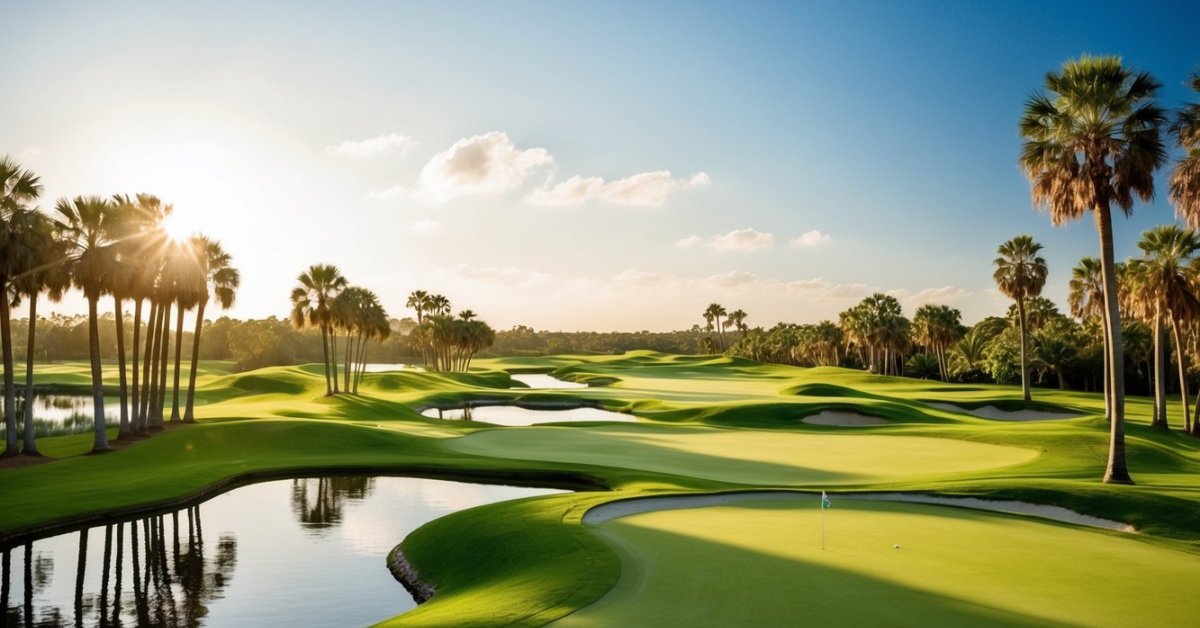Ever wondered what’s at the core of those little dimpled spheres you drive down the fairway? You might think golf balls are just simple plastic orbs, but there’s more to them than meets the eye. In this deep dive, we’ll unravel the mystery of golf ball composition.

You’ll be surprised to learn about the sophisticated technology and materials that make up a golf ball. It’s not just about plastic; it’s a tale of innovation and engineering that affects your game more than you might realize. Stick around as we tee off into the world of golf ball construction.
The Composition of Golf Balls
If you’ve ever sliced open a golf ball after a particularly powerful shot—hey, it happens—you’ll know they’re more than just simple spherical shells. The composition of these little marvels is quite the testament to sports engineering.
First up, the core. It’s the heart of the ball and typically made from a synthetic rubber compound. Polybutadiene, a type of rubber known for its high resilience, is the star player here. This material gives your ball the “oomph” you feel off the tee—the spring that launches it onto the fairway or right onto the green.
Surrounding the core, you’ll find the mantle, which can be one or more layers. These layers are crafted from materials like ionomer resins, which tweak the ball’s feel and control. As a low handicapper, you appreciate that these nuanced adjustments can significantly influence your game, offering that delicate balance between soft feel and distance.
Then there’s the cover, which in most advanced balls isn’t plain plastic, but a sturdy blend of urethane or Surlyn. These substances have a major impact on your ball’s durability and aerodynamics. While urethane provides that soft, spin-friendly touch around the greens, Surlyn stands up to the wear and tear of the course like a champ.
Spin, Feel, and Performance
Gone are the days when all balls felt the same off the clubface. Modern golf balls are designed with a specific purpose:
- Low-compression balls for softer feel
- High-compression for the long hitters
- Multi-layered balls for a mix of distance and control
Your choice of ball can indeed change how your shots play out. Opting for a high-spin ball might give you that edge on approach shots, but can be less forgiving on mishits. Meanwhile, a low-spin ball can extend your drives but might not give you the workability you desire in short games.
Understanding the intricacies of golf ball composition is like getting a window into your own game’s potential. Each material, each layer, plays into how the ball behaves in flight and upon landing, and knowing this will help you better tailor your equipment to your style of play. Remember, what you’re teeing up isn’t just a ‘plastic ball’—it’s a precision instrument designed to react to your every stroke.
Exploring Golf Ball Technology
« How Golf Ball Design Affects Your Game: Choose the Right One
How to Use Golf Ball Divot Tool: 5 Pro Tips for Perfect Greens »
As an avid golfer and someone who’s worked hard to lower your handicap, you know that advancements in golf ball technology have been a game-changer. Every little edge counts and keeping up with the latest trends can make a significant difference in your game. In the quest for greater precision and consistency on the course, manufacturers are pushing the boundaries of what’s possible with modern golf balls.
Inside the high-tech world of golf ball development, material science plays a starring role. The use of plastics, for instance, is not as straightforward as it might seem. While the terms “plastic” or even “synthetic” are broadly used, they don’t quite capture the sophistication behind the materials you’re driving down the fairway.
Take the cover of a golf ball as a perfect example. It’s not just about choosing between urethane and Surlyn; it’s about the precise formulation of these polymers. The development of urethane-covered balls has been a breakthrough for players like you who demand a softer feel without sacrificing durability. This cover material has unique properties that lend the ball a tender grip on the green, lending you that much-needed control for your short game.
The science of dimple patterns is another technological frontier. It’s all about optimizing aerodynamics to reduce drag and enhance lift. Engineers use advanced computer simulations to test countless variations, searching for the sweet spot that’ll make your shots more stable and predictable in flight.
- Urethane-based covers offer superior greenside control and feel.
- Surlyn-covered balls provide exceptional durability and are great for players looking for distance.
In the heart of the ball, manufacturers are now incorporating various layers to capitalize on benefits like energy transfer and spin rates. It’s common to find multi-layer designs that provide a balance between long distance shots and soft landings. The core and mantle designs work in unison to achieve the desired performance whether you’re on the tee box or approaching the 18th green, ensuring that you have the right tool in hand for every shot.
The Role of Plastic in Golf Ball Construction
As an avid golfer with an eye for detail, you’re probably curious about what goes into making the very tool you rely on for every swing—the golf ball. It might surprise you to learn that plastic is a key component in golf ball construction. Plastics, primarily polymers, are used for both the outer cover and the inner layers of the ball. Understanding how plastic contributes to your golf ball’s performance could change the way you view your next shot.
The cover of the golf ball is your point of contact, where you impart the all-important spin and feel. Commonly made from urethane or Surlyn, these plastic materials offer distinct advantages. Urethane covers are typically favored by low handicappers like yourself, who value a softer feel and greater spin control, crucial for precision shots around the green. On the other hand, Surlyn covers are known for their durability and resilience, making them a practical choice for golfers who prioritize long-term use.
Beyond the cover, plastic plays a role in the internal structure of the golf ball. Multi-layered balls often feature a core that includes a solid rubber center, encased in a plastic-based material called the mantle. This layer is engineered to manipulate ball flight characteristics such as distance, spin, and feel. The number of layers and the composition of plastics in these layers can vary significantly from ball to ball, each designed to meet different playing styles and conditions.
Interestingly, advancements in plastic technology have allowed manufacturers to fine-tune a golf ball’s performance more intricately than ever before. The precise chemical makeup of the polymers used can be altered to adjust compression, hardness, and even the ball’s reaction to temperature changes.
Whether you’re playing a casual round or competing in a tournament, the plastic within your golf ball is working hard to ensure that you can execute every shot as intended. It’s worth contemplating how the choice of materials—right down to the type of plastic—affects your game the next time you’re selecting a golf ball that matches your skill level.
Different Types of Golf Balls
As you delve further into the golf world, you’ll notice that balls come in several types, each crafted to enhance various aspects of your game. You’ve probably experienced the bewildering array of choices at your local golf shop. Let’s break down the options.
Two-Piece Golf Balls are the go-to for beginners and high-handicap players. These balls consist of a solid rubber core surrounded by a durable plastic cover, often made from Surlyn. They’re built for maximum distance and durability, meaning they’ll survive those occasional mis-hits into the trees. With these, you sacrifice some feel and spin control, but you gain a helping hand in straightening those wayward shots.
Moving up the skill ladder, Multi-Layered Golf Balls typically have three or four layers and are favored by the more skilled golfers looking for a blend of distance and control. The core is still usually rubber, but additional layers are designed to promote a better energy transfer and spin separation. For instance, a three-piece ball might have a core, mantle, and thinner urethane cover, offering more spin control on the greens compared to its two-piece cousins.
Advanced Golf Balls often have urethane covers and cater to players like you who have honed their game. The softer feel of the urethane allows for precision control around the green and provides the spin needed to shape shots. But don’t be mistaken—the high-tech polymers and advanced core design also help these balls achieve impressive distances. It’s a matter of physics and finesse coming together.
For swing speeds that really push the envelope, High-Performance Balls with multi-layer construction and a softer feel can optimize your game further. With these balls, manufacturers tweak the inner layers and cover designs to produce results tailored to your high-level play. Whether you need a higher launch, reduced spin off the driver, or more workability, there’s a high-performance ball out there for your specific needs.
Each type of golf ball serves a purpose in enhancing your play. Consider your handicap, swing speed, and what you’re striving to improve when choosing your next dozen. With the right ball, those plastics are not just materials; they’re tools for your sporting artistry on the course.
Conclusion
Frequently Asked Questions
What are the main types of golf balls discussed in the article?
The article discusses four main types of golf balls: two-piece balls, multi-layered balls, advanced balls, and high-performance balls, each designed for different levels of play and specific enhancements.
Who should use two-piece golf balls?
Two-piece golf balls are ideal for beginners and high-handicap golfers because they provide maximum distance and durability.
What advantages do multi-layered golf balls offer?
Multi-layered golf balls offer skilled golfers better spin control and energy transfer, helping to improve precision and playability.
Are advanced golf balls suitable for all golfers?
No, advanced golf balls are specifically designed for players with lower handicaps and higher swing speeds who require more nuanced performance characteristics.
How do high-performance golf balls differ from other types?
High-performance golf balls are optimized to provide the best possible performance for high-level play, with features tailored to professional and highly skilled amateur golfers.
How should a golfer choose the right golf ball?
A golfer should consider their handicap, swing speed, and the specific aspects of their game they wish to improve when selecting the appropriate golf ball.










